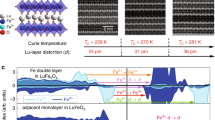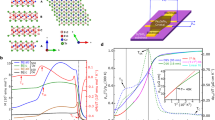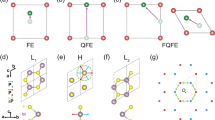Abstract
Ferroelectric materials are widely used in modern electric devices such as memory elements, filtering devices and high-performance insulators. Ferroelectric crystals have a spontaneous electric polarization arising from the coherent arrangement of electric dipoles1 (specifically, a polar displacement of anions and cations). First-principles calculations2,3 and electron density analysis4 of ferroelectric materials have revealed that the covalent bond between the anions and cations, or the orbital hybridization of electrons on both ions, plays a key role in establishing the dipolar arrangement. However, an alternative model—electronic ferroelectricity5—has been proposed in which the electric dipole depends on electron correlations, rather than the covalency. This would offer the attractive possibility of ferroelectric materials that could be controlled by the charge, spin and orbital degrees of freedom of the electron. Here we report experimental evidence for ferroelectricity arising from electron correlations in the triangular mixed valence oxide, LuFe2O4. Using resonant X-ray scattering measurements, we determine the ordering of the Fe2+ and Fe3+ ions. They form a superstructure that supports an electric polarization consisting of distributed electrons of polar symmetry. The polar ordering arises from the repulsive property of electrons—electron correlations—acting on a frustrated geometry.
This is a preview of subscription content, access via your institution
Access options
Subscribe to this journal
Receive 51 print issues and online access
$199.00 per year
only $3.90 per issue
Buy this article
- Purchase on Springer Link
- Instant access to full article PDF
Prices may be subject to local taxes which are calculated during checkout




Similar content being viewed by others
References
Kittel, C. Introduction to Solid State Physics (Wiley, New York, 1995)
Cohen, R. E. Origin of ferroelectricity in perovskite oxides. Nature 358, 136–138 (1992)
Sághi-Szabó, G., Cohen, R. E. & Krakauer, H. First-principles study of piezoelectricity in PbTiO3 . Phys. Rev. Lett. 80, 4321–4324 (1998)
Kuroiwa, Y. et al. Evidence for Pb-O covalency in tetragonal PbTiO3 . Phys. Rev. Lett. 87, 217601 (2001)
Portengen, T., Östreich, Th. & Sham, L. J. Theory of electronic ferroelectricity. Phys. Rev. B 54, 17452–17463 (1996)
Kimizuka, N., Muromachi, E. & Siratori, K. in Handbook on the Physics and Chemistry of Rare Earths Vol. 13 (eds Gschneidner, K. A. Jr & Eyring, L.) 283–384 (Elsevier Science, Amsterdam, 1990)
Yamada, Y., Nohdo, S. & Ikeda, N. Incommensurate charge ordering in charge-frustrated LuFe2O4 system. J. Phys. Soc. Jpn 66, 3733–3736 (1997)
Mekata, M. & Adachi, K. Magnetic structure of CsCoCl3 . J. Phys. Soc. Jpn 44, 806–812 (1978)
Funahashi, S. et al. Two-dimensional spin correlation in YFe2O4 . J. Phys. Soc. Jpn 53, 2688–2696 (1984)
Materlik, G., Sparks, C. J. & Fischer, K. Resonant Anomalous X-Ray Scattering (North-Holland, Amsterdam, 1994)
Sasaki, S. Fe2+ and Fe3+ ions distinguishable by X-ray anomalous scattering: method and its application to magnetite. Rev. Sci. Instrum. 66, 1573–1576 (1995)
Murakami, Y. et al. Direct observation of charge and orbital ordering in La0.5Sr1.5MnO4 . Phys. Rev. Lett. 80, 1932–1935 (1998)
Ikeda, N. et al. Charge frustration and dielectric dispersion in LuFe2O4 . J. Phys. Soc. Jpn 69, 1526–1532 (2000)
Hill, A. N. Why are there so few magnetic ferroelectrics? J. Phys. Chem. B 104, 6694–6709 (2000)
Ikeda, N., Kohn, K., Kito, H., Akimitsu, J. & Siratori, K. Dielectric relaxation and hopping of electrons in ErFe2O4 . J. Phys. Soc. Jpn 63, 4556–4564 (1994)
Tanaka, M., Siratori, K. & Kimizuka, N. Mössbauer study in RFe2O4 . J. Phys. Soc. Jpn 53, 760–772 (1984)
Acknowledgements
The authors express their gratitude to H. Suematsu and M. Takata for discussions.
Author information
Authors and Affiliations
Corresponding author
Ethics declarations
Competing interests
Reprints and permissions information is available at npg.nature.com/reprintsandpermissions. The authors declare no competing financial interests.
Rights and permissions
About this article
Cite this article
Ikeda, N., Ohsumi, H., Ohwada, K. et al. Ferroelectricity from iron valence ordering in the charge-frustrated system LuFe2O4. Nature 436, 1136–1138 (2005). https://doi.org/10.1038/nature04039
Received:
Accepted:
Issue Date:
DOI: https://doi.org/10.1038/nature04039
This article is cited by
-
Pressure-induced charge orders and their postulated coupling to magnetism in hexagonal multiferroic LuFe2O4
npj Quantum Materials (2023)
-
Impacts of Mn-deficiency on the structure and physical properties of GdMnO3 ceramics
Journal of Materials Science: Materials in Electronics (2023)
-
Spin-phonon coupling-mediated magnetodielectricity in B-site disordered PrFe0.5Mn0.5O3
Journal of Materials Science: Materials in Electronics (2023)
-
The structure, vacancy characteristics, and magnetic and dielectric properties of GdMn1-xWxO3 ceramics
Journal of Materials Science: Materials in Electronics (2022)
-
An antisite defect mechanism for room temperature ferroelectricity in orthoferrites
Nature Communications (2021)
Comments
By submitting a comment you agree to abide by our Terms and Community Guidelines. If you find something abusive or that does not comply with our terms or guidelines please flag it as inappropriate.



